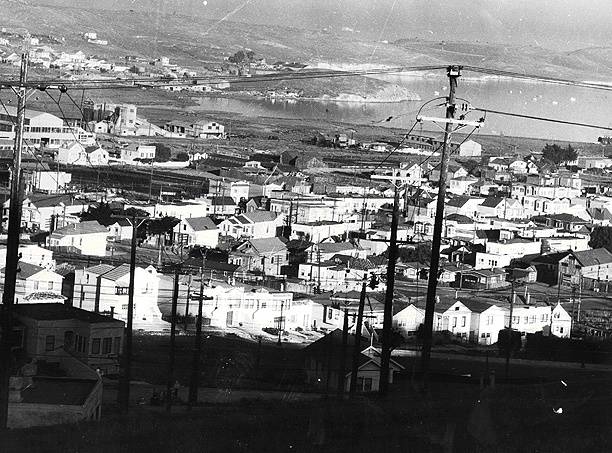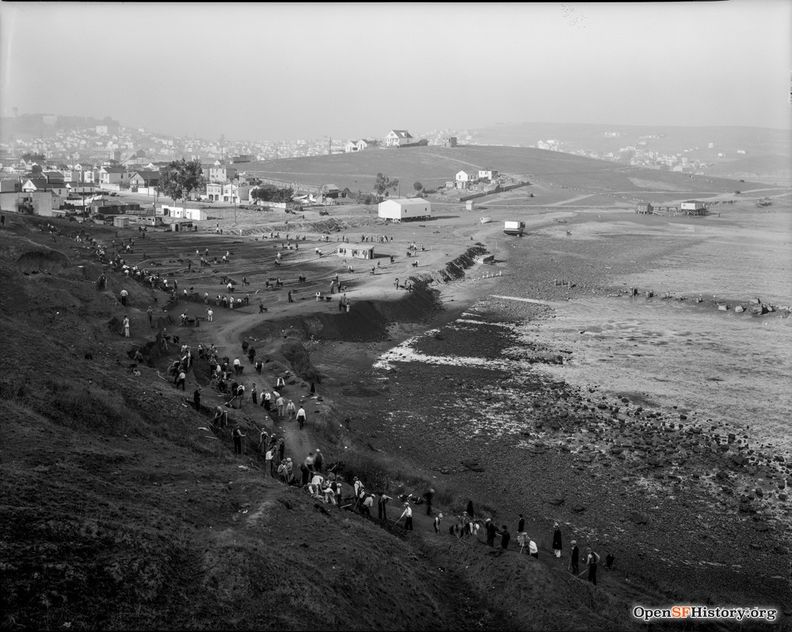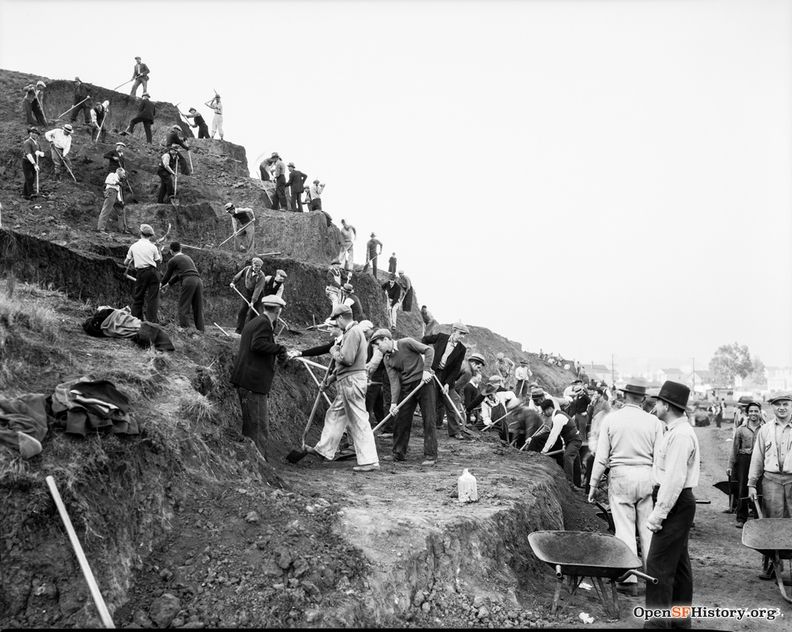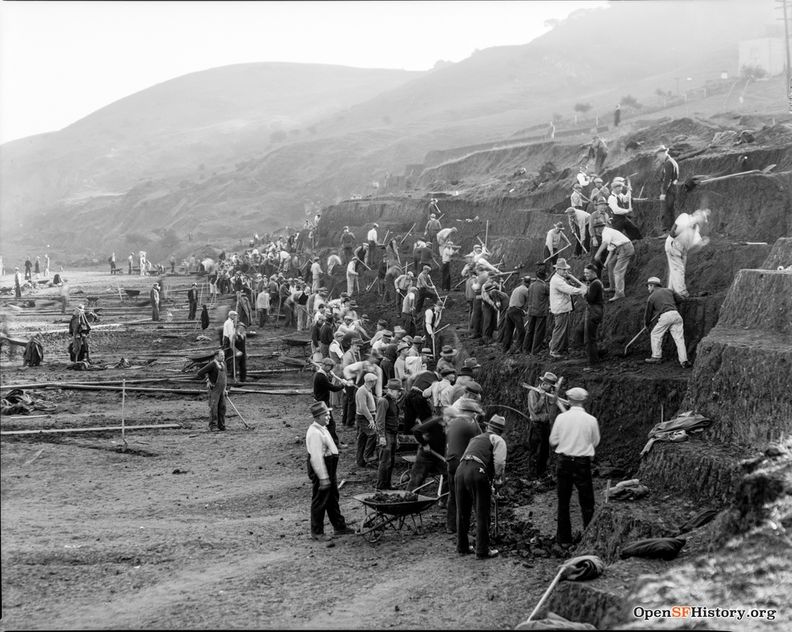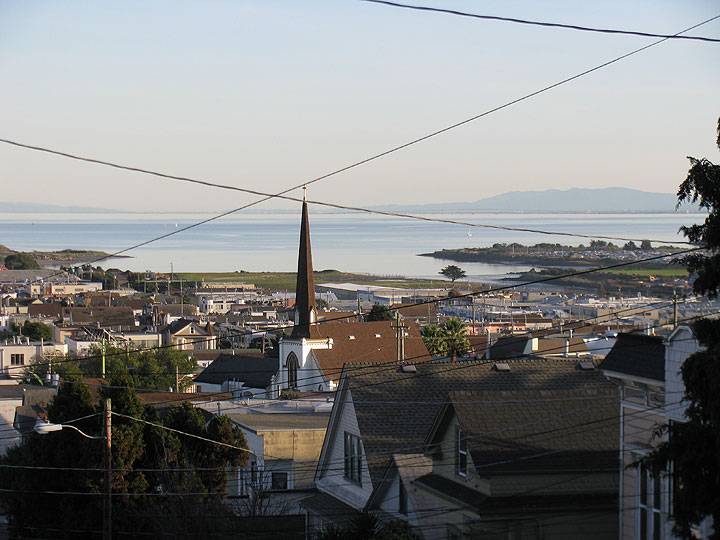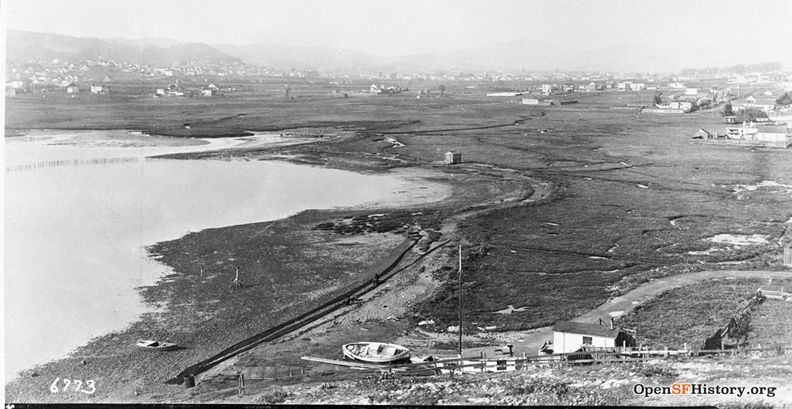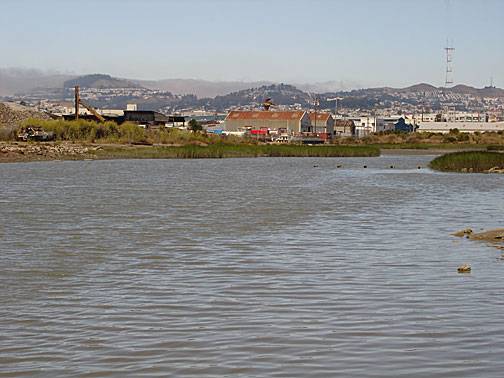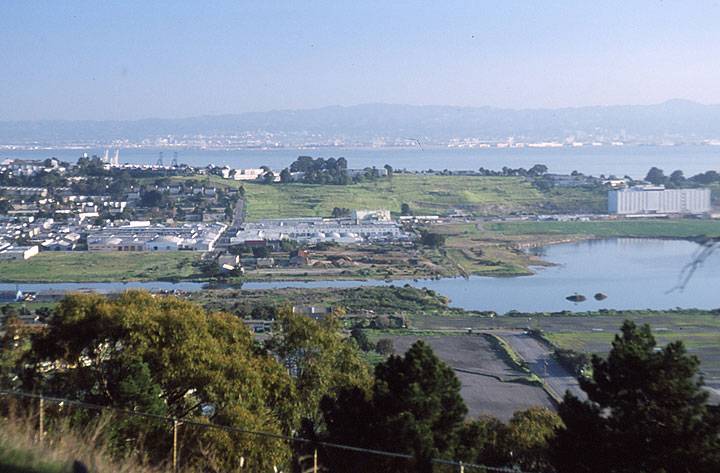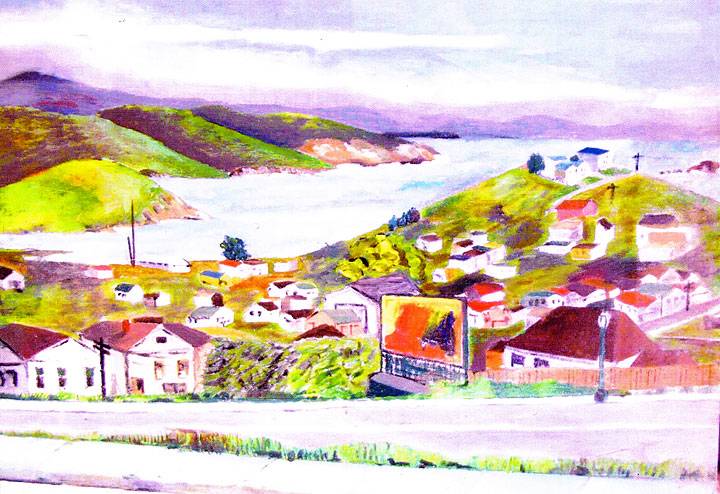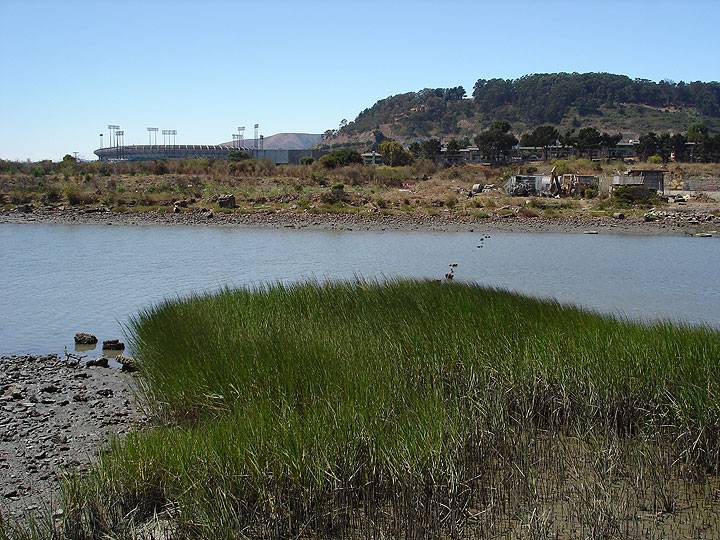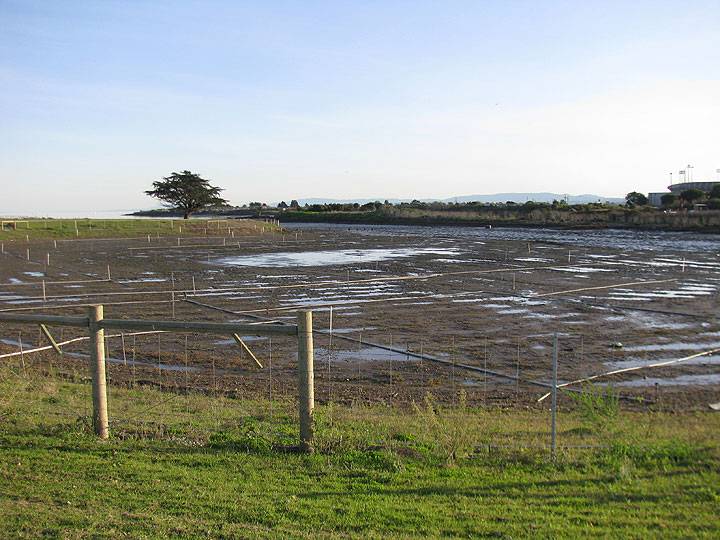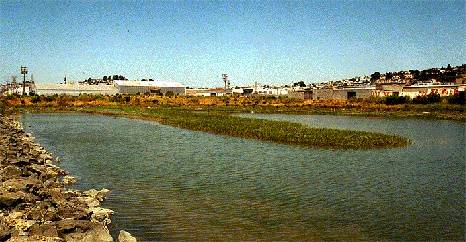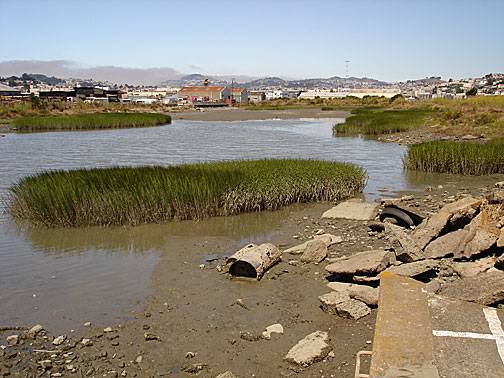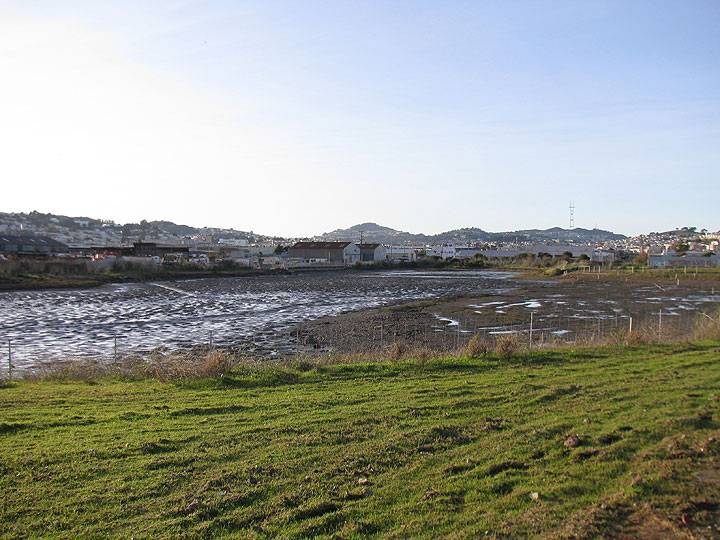Lost Beach Near Yosemite Creek: Difference between revisions
Texteradmin (talk | contribs) No edit summary |
(added abstract) |
||
| (13 intermediate revisions by 3 users not shown) | |||
| Line 1: | Line 1: | ||
'''<font face = | '''<font face = Papyrus> <font color = maroon> <font size = 4>"I was there..."</font></font> </font>''' | ||
''By Ruth Eshow Upton'' | |||
(Originally titled "The Beach") | |||
[[Image:bayvwhp$yosemite-creek-1928.jpg]] | [[Image:bayvwhp$yosemite-creek-1928.jpg]] | ||
| Line 5: | Line 9: | ||
'''Yosemite Creek in 1928, just south of Hunters Point. ''' | '''Yosemite Creek in 1928, just south of Hunters Point. ''' | ||
''Photo: | ''Photo: Private Collection, San Francisco, CA'' | ||
[[Image:Gilman and Bayview Hill Dec 26 1933 wnp14.2409.jpg|792px]] | |||
'''View from Bayview Hill north over Gilman playground construction at edge of beach, Dec. 26, 1933.''' | |||
''Photo: OpenSFHistory.org wnp14.2409.jpg'' | |||
{| style="color: black; background-color: #F5DA81;" | |||
| colspan="2" |'''Author and former Bayview resident Ruth Eshow Upton recounts blissful summer days of her childhood in the 1920s-30s spent at a sandy cove near Yosemite creek near what is now the former site of Candlestick Park. She recaptures the landscape and culture of the lost cove, from the routine her family and friends performed each time they prepared to visit it, to the yearly replacement of a shoddy makeshift diving board leftover from an old wharf. Upton also provides insight into how her perception of it changed as she matured, eventually moved across the city, and rediscovered it in the 1970s as a polluted cesspool rather than an inviting bayside beach. However, Upton remains optimistic that someday, due to the work of ecological restoration projects, other Bayview families may be able to enjoy the area as she once did. ''' | |||
|} | |||
Summer vacations in the Bayview during the 1920s and 1930s meant swimming in the bay almost every day. We had four beaches in our area from which to choose: Hunters Point, Candlestick, Gilman and a small cove just a block down from Gilman, at the end of Egbert Avenue. Hunters Point was out; it was too far to walk. Besides, the slaughterhouses lining Evans Avenue fouled the air. People did drive to Hunters Point on Sundays, though, for the bags of [[Chinese shrimping village|freshly cooked shrimp caught and sold by Chinese fishermen]]. Candlestick’s rocky shore and its steady wind were unfriendly. Gilman wasn’t bad but it was open to the afternoon westerlies. These winds meant, of course, that the sun shone in the Bayview during the months of June, July, and August. We felt so superior to the people who lived out in the Sunset and Richmond district and were fogged in during school vacation. We always headed for the cove around the bend from Gilman, a small, protected strip of sand on the bayside of a hill that separated it from Egbert Avenue. | |||
Before leaving for the beach in the morning we had to know in which direction the tide was moving. From my bedroom window on the second floor of our house on Le Conte Avenue I had a clear view of South Basin. I’d note the tide line. At intervals I’d look to see which way it was going. If it was receding, we waited until it turned. Getting there at low tide would mean staring at a mudflat until it came in again, a dreary waste of time. As soon as we knew the tide was coming in, we got our things together, filling a shopping bag with towels, sweaters and lunch. We wore our bathing suits under our clothes. Then the troupe—five children led by my 4’10” mother, started out, following the eucalyptus shaded lane past the Schmelter’s house, over to Key Avenue, then east to Third, down Third to Gilman. From a couple of backyards on Gilman often came a clicking sound which we identified as a game of bocce ball being played. How long it took us to get to the beach and how far we had walked I don’t know—half a mile? A mile? It made no difference; walking was the only way to get there. Public transportation—on San Bruno Avenue and on Third Street—went north and south. Driving there was not an option. The family car (called “the machine”) was driven only by fathers on their days off for visits, trips to Golden Gate Park, Fleischacker's Playground or Neptune Beach in Alameda (involving a ferry ride.). Mothers didn’t drive. | |||
[[Image:Bayview Hill 1933 wnp14.2407.jpg|792px]] | |||
'''Bayview Hill being carved out near Gilman and Egbert beach, 1933.''' | |||
''Photo: OpenSFHistory.org wnp14.2407.jpg'' | |||
[[Image:Bayview Hill Gilman 1933 wnp14.2408.jpg|792px]] | |||
'''Bayview Hill grading, 1933.''' | |||
''Photo: OpenSFHistory.org wnp14.2408.jpg'' | |||
[[Image:Yosemite-slough-from-silver-terrace 1415.jpg]] | |||
'''Yosemite Creek basin from Silver Terrace hill, December 2012.''' | |||
''Photo: Chris Carlsson'' | |||
[[Image:Yosemite Slough 1920 wnp36.02429.jpg|792px]] | |||
'''Yosemite creek and surroundings, c. 1920.''' | |||
''Photo: OpenSFHistory.org wnp36.02429.jpg'' | |||
[[Image:Yosemite-creek-with-fog-shrouded-hills0921.jpg]] | [[Image:Yosemite-creek-with-fog-shrouded-hills0921.jpg]] | ||
| Line 12: | Line 55: | ||
''Photo: Chris Carlsson'' | ''Photo: Chris Carlsson'' | ||
[[Image:Yosemite-creek-from-bayview-hill-20.jpg]] | |||
'''Yosemite Creek, with the two protruding rocks known as "Double Rock" in mouth, as seen from Bayview Hill on a sunny winter day. Hunters Point is swathed in uncharacteristic green.''' | |||
''Photo: Alan Hopkins, Golden Gate Audubon Society'' | |||
[[Image:View-of-bay-from-Le-Conte-Ave-Pauline-Aldredge-watercolor.jpg]] | |||
'''View of the bay from Le Conte Avenue; our swimming cove was under the hill at right, foot of Egbert Avenue. Painting by Pauline Zarosi Aldredge.''' | |||
''Courtesy Ruth Eshow'' | |||
We turned off Gilman, following the shore to our cove. Its main attractions were the tawny sand beach and the remains of a wharf that stood out in deep water. Crustaceans covered the piles. A rickety ladder gave access to a rotted plank-covered floor. A narrow board nailed to the edge served as a diving board. Almost every year it cracked under the weight of constant jumping and had to be replaced. Tied to the barnacle-encrusted piling was a raft. That raft was not only the swimmer’s goal but a symbol. When you finally lost your fear of being in water over your head and swam all the way to the raft you had graduated from kid-hood. | |||
When we reached this mastery, Virginia Zarosi, who lived next door with her sister Pauline, and I swam out to the raft, then stretched out on it. As it drifted lazily in semi-circles a golden-red light penetrating our closed eyes, we daydreamed about what the future might hold as we worked on our tans. | |||
The water was chilly but we took it for granted that that’s how it was supposed to be; it was not a hindrance. And it wasn’t as cold as the Pacific Ocean. At Kelly’s Cove, below the Cliff House where my mother sometimes took us, I would have to make three tries before I got used to the icy water. The first two times I would come out, dig my numb toes into the sand and wiggle them to thaw out. That prepared me for the third attempt, after which I didn’t notice it any more. We body-surfed only, not daring to go out beyond the huge breakers. If you didn’t catch a wave on the crest you were tumbled over and over again until you landed on the beach, dizzy, with a bathing suit filled with sand and gravel. | |||
[[Image:South-view-across-Yosemite-creek-0912.jpg]] | [[Image:South-view-across-Yosemite-creek-0912.jpg]] | ||
'''South across Yosemite creek, [[Candlestick view|Candlestick Park]] under Bayview Hill. This area is now part of the [[Candlestick Point State Recreation Area|Candlestick Point State Recreation Area]].''' | '''South across Yosemite creek, [[Candlestick view|Candlestick Park]] under Bayview Hill. This area is now part of the [[Candlestick Point State Recreation Area|Candlestick Point State Recreation Area]].''' | ||
''Photo: Chris Carlsson'' | |||
[[Image:Yosemite-slough-wetland-restoration-low-tide 1408.jpg]] | |||
'''Wetland restoration in Yosemite Slough, December 2012, looking southeast from north shore, Candlestick Park at right.''' | |||
''Photo: Chris Carlsson'' | |||
In our cove, babies sat safely at the water’s edge, playing with their pails and shovels. Small children waded out to waist-high, clear water, and pretended to swim to shore by walking on their hands and kicking their feet, the way I had done when I was small. Mothers usually sat on the beach watching us. My mother would have loved to go in but was too modest to appear almost naked in public. Virginia’s mother, an American of Scotch descent, had no such qualms. She usually swam a dignified side stroke. | |||
We emerged from the water only when it was time to eat. Shivering, towels draped around our shoulders, we dived into the goodies my mother had prepared. Mostly they were left-overs, like cold ''kufta'' (spicy Armenian meatballs of lamb and rice). ''Cheorag'', soft, golden-crusted rolls, were a treat. For dessert we might enjoy Eskimo pies if the ice cream man showed up. It had to be eaten quickly before the chocolate started to melt. | |||
There were no amenities on this beach unless you counted the ghostly frame of a concrete structure that stood not too far from the cove. Someone said it was supposed to have been a power house whose construction was halted for reasons not known to. It lacked a roof and doors but it did afford some privacy for small children who might have to do what was then referred to as Number Two. Its distance from where we played and a constant breeze kept it from becoming a smelly nuisance. As for Number One, we all peed in the bay. Old-time beachgoers had many theories about the power of salt water. One was that it worked like an antiseptic and that the pee would mingle with the brine and would dissipate before it ended up in Alameda on the other side of the bay. Another theory was that you should not wash off salt water before you got home or you’d catch a cold. According to this theory, the salt covered the pores and protected you from germs. It may have been true because I don’t remember being subject to colds. | |||
We left the beach when the tide was on its way out. Our bathing suits, worn under our clothes, were damp and itchy. And there was the afternoon westerly. To keep us from quarreling, my mother invented diversions. One was a stop at the house of my best friends’s aunt, Mrs. Jessen, at the beach end of Gilman. In her backyard was a large, free-standing wire cage which housed her pet monkey. The cage was fitted out with tropical plants and perches. We loved watching the monkey’s antics. Another was a walk to Candlestick, up the east side of [[Bayview Hill|Black Mountain]]. Halfway up the hill, in a grove of trees facing the bay, were three swings, adult- sized ones. Who put them there was a mystery. We never saw anyone else use them. For us it was a thrill to stand on the swing’s seat, pumping hard. The trees and the ground disappeared. We felt the thrill of flight as we flew out over the bay.. | |||
Except for hearing of the tragedy of a boy who broke his neck as a result of diving off the wharf at low tide, there were no dramatic moments. We went from skinny little girls who didn’t care what we wore, our wet hair stringy, plastered to our heads, oblivious of the resemblance to drowned rats, to our adolescent years when we became conscious of the boys. I was embarrassed by my black woolen suit with its high back when I saw other girls in the latest low-cut suits. To accommodate me my mother altered it creating a scooped back that gave it a modern look. Years later I found a wool tank suit at Roos Brothers that was an up-to-date version of it. I wore it until it disappeared when my luggage was stolen at the airport in Puerto Vallarta. | |||
As for the boys, a family of five brothers, the Boehle boys, blond, tall, good-looking, masters of the diving board , attracted our admiration. But they paid no attention to us, instead concentrating on jumping off the board, climbing back on and repeating it until the tide started to go out. | |||
Sometime around the years 1936 or 1937 signs announcing “Polluted Water” were posted along the beach. We wondered if it had always been polluted. I do remember a couple of times after a day at the beach of running a slight fever at night, a fever that always produced the same nightmare: a conveyor belt of white butcher paper that had been crumpled and straightened out but still showed wrinkles, on which auto tires rolled, first slowly, then faster and faster until I woke up. Something in the bay may have affected me but whatever it was didn’t harm me and may, in fact, have vaccinated me against unknown terrible diseases. | |||
In 1939 we moved to the Richmond. I never went back. Our neighborhood had disappeared completely when the freeway replaced the [[Old Bayshore Highway|old Bayshore Highway]] and with the construction of [[Candlestick Swindle|Candlestick Park]]. And I had discovered China and Bakers Beach as well as Aquatic Park. The end of the war put the auto industry back into business of producing cars for civilians. With my brand-new beige 1948 Plymouth Club Coupe I explored California beaches from Marin to Monterey counties. In the ‘50s airline travel made it possible to pursue my vague dream to swim the Seven Seas in search of the perfect beach. Though I never managed to reach all seven I did discover many beautiful spots. | |||
In the mid-seventies, when I worked at City Hall, curiosity galvanized me into driving out to see what had happened to our cove. It was a dismal sight. The hill at the end of Egbert covered with flimsy looking buildings that had housed shipyard workers during the war stood abandoned, forlorn. The sand beach was gone as was the old wharf. Rainbow-colored water, oily looking, lapped against the bottom of the hill. Debris floated in the shallows. I left, never to return. | |||
Then I saw the documentary film, ''SAVING THE BAY'', and I was cheered. Though I’ll never swim in the bay again it’s heartening to think that future San Francisco kids may one day enjoy the same pleasures that we lucky kids in the Bayview had, in the sun and free of charge. | |||
[[Image:bayvwhp$yosemite-creek-1996.jpg]] | |||
'''Yosemite Creek 1996, between Hunters Point and Candlestick Park.''' | |||
''Photo: Chris Carlsson'' | ''Photo: Chris Carlsson'' | ||
| Line 25: | Line 118: | ||
''Photo: Chris Carlsson'' | ''Photo: Chris Carlsson'' | ||
[[Image: | [[Image:Yosemite-slough-westerly-at-low-tide 1392.jpg]] | ||
'''Yosemite Creek | '''Yosemite Creek, December 2012, looking southwest from the newly restored north shore.''' | ||
''Photo: Chris Carlsson'' | ''Photo: Chris Carlsson'' | ||
| Line 35: | Line 128: | ||
[[Image:Tours-water.gif|link= CISTERNS]] [[CISTERNS| Continue Water Tour]] | [[Image:Tours-water.gif|link= CISTERNS]] [[CISTERNS| Continue Water Tour]] | ||
[[ | [[Haley & O'Neill Tract | Prev. Document]] [[Candlestick Point State Recreation Area |Next Document]] | ||
[[category:Bayview/Hunter's Point]] [[category:1920s]] [[category:1990s]] [[category:Water]] | [[category:Bayview/Hunter's Point]] [[category:1920s]] [[category:1990s]] [[category:Water]] | ||
[[category:2000s]] [[category:shoreline]] | [[category:2000s]] [[category:shoreline]] [[category:1930s]] | ||
Latest revision as of 12:10, 4 June 2021
"I was there..."
By Ruth Eshow Upton
(Originally titled "The Beach")
Yosemite Creek in 1928, just south of Hunters Point.
Photo: Private Collection, San Francisco, CA
View from Bayview Hill north over Gilman playground construction at edge of beach, Dec. 26, 1933.
Photo: OpenSFHistory.org wnp14.2409.jpg
| Author and former Bayview resident Ruth Eshow Upton recounts blissful summer days of her childhood in the 1920s-30s spent at a sandy cove near Yosemite creek near what is now the former site of Candlestick Park. She recaptures the landscape and culture of the lost cove, from the routine her family and friends performed each time they prepared to visit it, to the yearly replacement of a shoddy makeshift diving board leftover from an old wharf. Upton also provides insight into how her perception of it changed as she matured, eventually moved across the city, and rediscovered it in the 1970s as a polluted cesspool rather than an inviting bayside beach. However, Upton remains optimistic that someday, due to the work of ecological restoration projects, other Bayview families may be able to enjoy the area as she once did. |
Summer vacations in the Bayview during the 1920s and 1930s meant swimming in the bay almost every day. We had four beaches in our area from which to choose: Hunters Point, Candlestick, Gilman and a small cove just a block down from Gilman, at the end of Egbert Avenue. Hunters Point was out; it was too far to walk. Besides, the slaughterhouses lining Evans Avenue fouled the air. People did drive to Hunters Point on Sundays, though, for the bags of freshly cooked shrimp caught and sold by Chinese fishermen. Candlestick’s rocky shore and its steady wind were unfriendly. Gilman wasn’t bad but it was open to the afternoon westerlies. These winds meant, of course, that the sun shone in the Bayview during the months of June, July, and August. We felt so superior to the people who lived out in the Sunset and Richmond district and were fogged in during school vacation. We always headed for the cove around the bend from Gilman, a small, protected strip of sand on the bayside of a hill that separated it from Egbert Avenue.
Before leaving for the beach in the morning we had to know in which direction the tide was moving. From my bedroom window on the second floor of our house on Le Conte Avenue I had a clear view of South Basin. I’d note the tide line. At intervals I’d look to see which way it was going. If it was receding, we waited until it turned. Getting there at low tide would mean staring at a mudflat until it came in again, a dreary waste of time. As soon as we knew the tide was coming in, we got our things together, filling a shopping bag with towels, sweaters and lunch. We wore our bathing suits under our clothes. Then the troupe—five children led by my 4’10” mother, started out, following the eucalyptus shaded lane past the Schmelter’s house, over to Key Avenue, then east to Third, down Third to Gilman. From a couple of backyards on Gilman often came a clicking sound which we identified as a game of bocce ball being played. How long it took us to get to the beach and how far we had walked I don’t know—half a mile? A mile? It made no difference; walking was the only way to get there. Public transportation—on San Bruno Avenue and on Third Street—went north and south. Driving there was not an option. The family car (called “the machine”) was driven only by fathers on their days off for visits, trips to Golden Gate Park, Fleischacker's Playground or Neptune Beach in Alameda (involving a ferry ride.). Mothers didn’t drive.
Bayview Hill being carved out near Gilman and Egbert beach, 1933.
Photo: OpenSFHistory.org wnp14.2407.jpg
Bayview Hill grading, 1933.
Photo: OpenSFHistory.org wnp14.2408.jpg
Yosemite Creek basin from Silver Terrace hill, December 2012.
Photo: Chris Carlsson
Yosemite creek and surroundings, c. 1920.
Photo: OpenSFHistory.org wnp36.02429.jpg
Yosemite Creek with San Francisco's fog-shrouded hills in distance, August, 2005.
Photo: Chris Carlsson
Yosemite Creek, with the two protruding rocks known as "Double Rock" in mouth, as seen from Bayview Hill on a sunny winter day. Hunters Point is swathed in uncharacteristic green.
Photo: Alan Hopkins, Golden Gate Audubon Society
View of the bay from Le Conte Avenue; our swimming cove was under the hill at right, foot of Egbert Avenue. Painting by Pauline Zarosi Aldredge.
Courtesy Ruth Eshow
We turned off Gilman, following the shore to our cove. Its main attractions were the tawny sand beach and the remains of a wharf that stood out in deep water. Crustaceans covered the piles. A rickety ladder gave access to a rotted plank-covered floor. A narrow board nailed to the edge served as a diving board. Almost every year it cracked under the weight of constant jumping and had to be replaced. Tied to the barnacle-encrusted piling was a raft. That raft was not only the swimmer’s goal but a symbol. When you finally lost your fear of being in water over your head and swam all the way to the raft you had graduated from kid-hood.
When we reached this mastery, Virginia Zarosi, who lived next door with her sister Pauline, and I swam out to the raft, then stretched out on it. As it drifted lazily in semi-circles a golden-red light penetrating our closed eyes, we daydreamed about what the future might hold as we worked on our tans.
The water was chilly but we took it for granted that that’s how it was supposed to be; it was not a hindrance. And it wasn’t as cold as the Pacific Ocean. At Kelly’s Cove, below the Cliff House where my mother sometimes took us, I would have to make three tries before I got used to the icy water. The first two times I would come out, dig my numb toes into the sand and wiggle them to thaw out. That prepared me for the third attempt, after which I didn’t notice it any more. We body-surfed only, not daring to go out beyond the huge breakers. If you didn’t catch a wave on the crest you were tumbled over and over again until you landed on the beach, dizzy, with a bathing suit filled with sand and gravel.
South across Yosemite creek, Candlestick Park under Bayview Hill. This area is now part of the Candlestick Point State Recreation Area.
Photo: Chris Carlsson
Wetland restoration in Yosemite Slough, December 2012, looking southeast from north shore, Candlestick Park at right.
Photo: Chris Carlsson
In our cove, babies sat safely at the water’s edge, playing with their pails and shovels. Small children waded out to waist-high, clear water, and pretended to swim to shore by walking on their hands and kicking their feet, the way I had done when I was small. Mothers usually sat on the beach watching us. My mother would have loved to go in but was too modest to appear almost naked in public. Virginia’s mother, an American of Scotch descent, had no such qualms. She usually swam a dignified side stroke.
We emerged from the water only when it was time to eat. Shivering, towels draped around our shoulders, we dived into the goodies my mother had prepared. Mostly they were left-overs, like cold kufta (spicy Armenian meatballs of lamb and rice). Cheorag, soft, golden-crusted rolls, were a treat. For dessert we might enjoy Eskimo pies if the ice cream man showed up. It had to be eaten quickly before the chocolate started to melt.
There were no amenities on this beach unless you counted the ghostly frame of a concrete structure that stood not too far from the cove. Someone said it was supposed to have been a power house whose construction was halted for reasons not known to. It lacked a roof and doors but it did afford some privacy for small children who might have to do what was then referred to as Number Two. Its distance from where we played and a constant breeze kept it from becoming a smelly nuisance. As for Number One, we all peed in the bay. Old-time beachgoers had many theories about the power of salt water. One was that it worked like an antiseptic and that the pee would mingle with the brine and would dissipate before it ended up in Alameda on the other side of the bay. Another theory was that you should not wash off salt water before you got home or you’d catch a cold. According to this theory, the salt covered the pores and protected you from germs. It may have been true because I don’t remember being subject to colds.
We left the beach when the tide was on its way out. Our bathing suits, worn under our clothes, were damp and itchy. And there was the afternoon westerly. To keep us from quarreling, my mother invented diversions. One was a stop at the house of my best friends’s aunt, Mrs. Jessen, at the beach end of Gilman. In her backyard was a large, free-standing wire cage which housed her pet monkey. The cage was fitted out with tropical plants and perches. We loved watching the monkey’s antics. Another was a walk to Candlestick, up the east side of Black Mountain. Halfway up the hill, in a grove of trees facing the bay, were three swings, adult- sized ones. Who put them there was a mystery. We never saw anyone else use them. For us it was a thrill to stand on the swing’s seat, pumping hard. The trees and the ground disappeared. We felt the thrill of flight as we flew out over the bay..
Except for hearing of the tragedy of a boy who broke his neck as a result of diving off the wharf at low tide, there were no dramatic moments. We went from skinny little girls who didn’t care what we wore, our wet hair stringy, plastered to our heads, oblivious of the resemblance to drowned rats, to our adolescent years when we became conscious of the boys. I was embarrassed by my black woolen suit with its high back when I saw other girls in the latest low-cut suits. To accommodate me my mother altered it creating a scooped back that gave it a modern look. Years later I found a wool tank suit at Roos Brothers that was an up-to-date version of it. I wore it until it disappeared when my luggage was stolen at the airport in Puerto Vallarta.
As for the boys, a family of five brothers, the Boehle boys, blond, tall, good-looking, masters of the diving board , attracted our admiration. But they paid no attention to us, instead concentrating on jumping off the board, climbing back on and repeating it until the tide started to go out.
Sometime around the years 1936 or 1937 signs announcing “Polluted Water” were posted along the beach. We wondered if it had always been polluted. I do remember a couple of times after a day at the beach of running a slight fever at night, a fever that always produced the same nightmare: a conveyor belt of white butcher paper that had been crumpled and straightened out but still showed wrinkles, on which auto tires rolled, first slowly, then faster and faster until I woke up. Something in the bay may have affected me but whatever it was didn’t harm me and may, in fact, have vaccinated me against unknown terrible diseases.
In 1939 we moved to the Richmond. I never went back. Our neighborhood had disappeared completely when the freeway replaced the old Bayshore Highway and with the construction of Candlestick Park. And I had discovered China and Bakers Beach as well as Aquatic Park. The end of the war put the auto industry back into business of producing cars for civilians. With my brand-new beige 1948 Plymouth Club Coupe I explored California beaches from Marin to Monterey counties. In the ‘50s airline travel made it possible to pursue my vague dream to swim the Seven Seas in search of the perfect beach. Though I never managed to reach all seven I did discover many beautiful spots.
In the mid-seventies, when I worked at City Hall, curiosity galvanized me into driving out to see what had happened to our cove. It was a dismal sight. The hill at the end of Egbert covered with flimsy looking buildings that had housed shipyard workers during the war stood abandoned, forlorn. The sand beach was gone as was the old wharf. Rainbow-colored water, oily looking, lapped against the bottom of the hill. Debris floated in the shallows. I left, never to return.
Then I saw the documentary film, SAVING THE BAY, and I was cheered. Though I’ll never swim in the bay again it’s heartening to think that future San Francisco kids may one day enjoy the same pleasures that we lucky kids in the Bayview had, in the sun and free of charge.
Yosemite Creek 1996, between Hunters Point and Candlestick Park.
Photo: Chris Carlsson
Yosemite Creek, unrestored in 2005, not far from where Green Tortoise bus lines maintained an informal camp for several years before being evicted.
Photo: Chris Carlsson
Yosemite Creek, December 2012, looking southwest from the newly restored north shore.
Photo: Chris Carlsson

